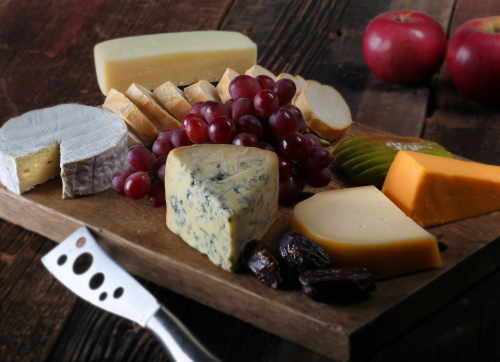A cheese platter is a staple of home entertaining, but spending a little extra time at the cheese shop can help you create a board that rises above the average lump of cheddar.
Cheese is probably the easiest appetizer to serve because it requires no preparation and is universally enjoyed. (There’s a reason why you see it at every party.)
When putting together a cheese platter, there are no rules, but there are a few guidelines that can help make the presentation both tasty and interesting.
First, consider how much cheese you will need.
D.J. Shisler, owner of Shisler’s Cheese House in Copley, Ohio, said the number of guests you will be serving helps to determine this, as well as whether the cheese will be one of the main offerings.
If you’re having just a wine and cheese affair, plan on about 4 ounces of cheese per person. If the cheese platter is one of several offerings, then no more than 2 ounces per guest.
Next consider how many different types of cheese to use. You’ll want at least three, but never more than six.
If you have more than six kinds, the cheeses start to lose their distinction, which, as Shisler said, is a major point. When making your selections, Shisler said the main goal is offering a variety of tastes and textures.
 |
A cheese platter is a staple of home entertaining, but spending a little extra time at the cheese shop can help you create a board that rises above the average lump of cheddar.(Akron Beacon Journal/MCT) |
“Make sure that every cheese you put on that platter is different and distinguishable,” he said.
Cheeses come from three main groups ― cow’s milk, goat’s milk, and sheep’s milk. The best plates offer a combination of the three. You can also pick a theme for the platter, serving all French cheeses, all Spanish or all Italian, for example.
With the number of quality cheeses made in Ohio, an all-Ohio platter is also an option. Shisler said many of his customers prefer a combination of Holmes County cheeses. But even with an all-Ohio selection, he encourages customers to try varieties that they wouldn’t normally consider, beyond the traditional cheddar and Swiss.
In “The Murray’s Cheese Handbook” (Broadway Books, 2006), authors Rob Kaufelt and Liz Thorpe suggest picking cheeses from the following seven groups: fresh, bloomy (like Brie or Camembert), washed rind (like Taleggio), semisoft, firm, hard and blue.
A good cheese shop will have a variety of each. Akron, Ohio’s West Point Market, for example, offers more than 400 types of cheeses and would have one to fit in each category.
Even if you just select three types of cheese, make sure they are each from a different group.
It’s always a good idea to include a veiny blue cheese in the mix. Shisler said folks are often surprised by blue cheese served on its own. They are so used to having it crumbled into salads that people often overlook it as a cheese to serve on a board.
Once you make your selections, arrange them on a platter in a clockwise position (you can begin at 6 or 12), starting with the mildest and ending with the strongest.
Finally, garnish the platter with flair.
Selecting the right accompaniments to go with the cheese is as important as choosing the cheese itself. Dried cured meats, olives, nuts, bread and dried and fresh fruit are all great, traditional choices.
But Shisler said other condiments, such as fig spread or mustards, go well with cheese. Shisler said Spanish quince paste, known as membrillo, is sweet and tart and offsets the sharpness of Spanish manchego, a sheep’s milk cheese.
Honey is another unexpected accompaniment that can be drizzled on blue or other sharp cheeses such as goat cheese, he said.
Grapes, pears, apples and figs all will help to round out the platter.
Shisler said it’s a good idea to leave the cheese in wedges, but cut a few slices from each to start them off.
When it comes to serving, always make sure that cheese has been allowed to sit at room temperature for at least half an hour or even an hour before serving.
Shisler said cheeses won’t spoil that quickly and the difference in taste between cold cheese and room temperature is remarkable.
By Lisa Abraham
(Akron Beacon Journal)
(MCT Information Services)








